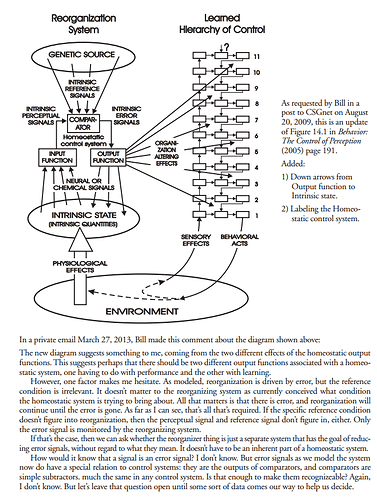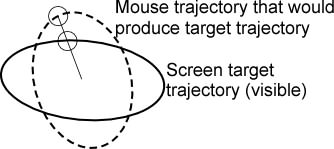[From Bruce Abbott (2016.08.07.0905 EDT)]
Rick Marken (2016.08.06.1200)
Bruce Abbott (2016.08.05.1055 EDT)
RM: The power law is just an artifact; an embarrassing result of looking at behavior through causal rather than control theory glasses. Isn’t it about time for you to change your prescription.
BA: Time for you to change yours. Attached is my own spreadsheet investigation of V versus R. …
BA: So here is an example that violates the power rule. Velocity along the curve (in units of length/time) is not a fixed power function of the circle’s radius, R, contrary to your assertion that V is a power function of R with an exponent of 1/3.
RM: I’m afraid that your nice spreadsheet does not provide an example that violates what you call the “power rule” (it’s called the “power law” in the literature). The problem is that your conclusion (that it does) is based on a misunderstanding of how the power law is determined. The power law is determined (for the 100th time) using linear regression on the log values of R and V (or C and A) to solve for the power coefficient b as in :
log (V) = a +b*log(R)
RM: The regression analysis solves for b, the power coefficient, and the R^2 of the regression tells how well the power law (the linear fit of the log-log values) fits the data. So I took your nice quarter circle (X,Y values), put it into my spreadsheet that performs the log-log regression and found the following regression equation:
log (V) = -.53+.5*log(R)
with an R^2 of .74, a pretty good fit of of the power law. So if your perfect quarter circle were the movement made by a human being a power law researcher would likely conclude that the power coefficient relating R to V is .5. You get the same result, by the way, for a complete circle – a power coefficient of .5 with R^2 = .74 – though the intercept value changes to .32.
BA: Ah, poor Rick! As a scientist of Laputa, you have attempted to extract sunshine from cucumbers, and now this – attempting to extract tangential velocity around a cirrcle, measured in units of distance/time, from a spreadsheet in which time is nowhere represented!
BA: In my spreadsheet, V is the tangential “velocity� measured in distance traveled along the circumference of a circle per degree of change in the central angle of the circle, and is measured in units of distance/degree. This “velocity� is a characteristic of any circle of a given radius. It is not the velocity (in distance covered per unit of time) with which a person might draw the circle.
BA: But alas, as an upstanding member of the Laputa scientific community, you will be unfazed by such criticism, such is your delusional state. You will continue to insist that the only proper way to analyze these data is by performing a regression analysis on the two fixed values that characterize the shape we call a circle – the circlee’s radius (R) and the length of the arc subtended by a one-degree change in angle (V). You will remain blissfully unaware that your regression of log(R) onto log(V) should blow up (because of the absence of any variance in R and V), but doesn’t because of the tiny variances introduced by taking discrete differences to compute dX, dY, ddX, and ddY when using the formulas to compute V and R from the motion of the point along the circumference.
BA: It’s all there to see in my spreadsheet (compare the actual radius and velocity (in distance/degree) to the values of R and D as estimated by the formulas for computing these values from changes in X and Y. But you didn’t bother to look, did you?
BA: But wait, you say, look how beta in the regression equation quickly approaches 1/3 as I transform the circle into a slightly elliptical form! Why does that happen? Why, it must be because people can’t draw perfect circles! Well, I imagine that makes sense to you and your scientific colleagues on Laputa, but elsewhere it just means that the distances traveled around the perimeter of an ellipse with each degree of change in the central angle (V in distance/degree) systematically varies, as does the radius of curvature (R). As you increase the ratio of the ellipse’s length to width, this variation in V and R increases, quickly swamping out the “noise� in the computed values of V and R. But again, you are finding a relationship that is a fixed characteristic of a given oval.
BA: the “Vâ€? in these computations has nothing to do with how quickly or slowly one draws a circle or ellipse. That’s a different “Vâ€? entirely, one measured in units of distance/time. I do wish you would have a sudden epiphany and understand all this, but your responses to all previous attempts by earthbound scientists to do so have been frustratingly ineffective. I guess it is a consequence of your seeing the world through Laputasian glasses. Please, I implore you – take them off!
Your humble servant,
Gulliver




